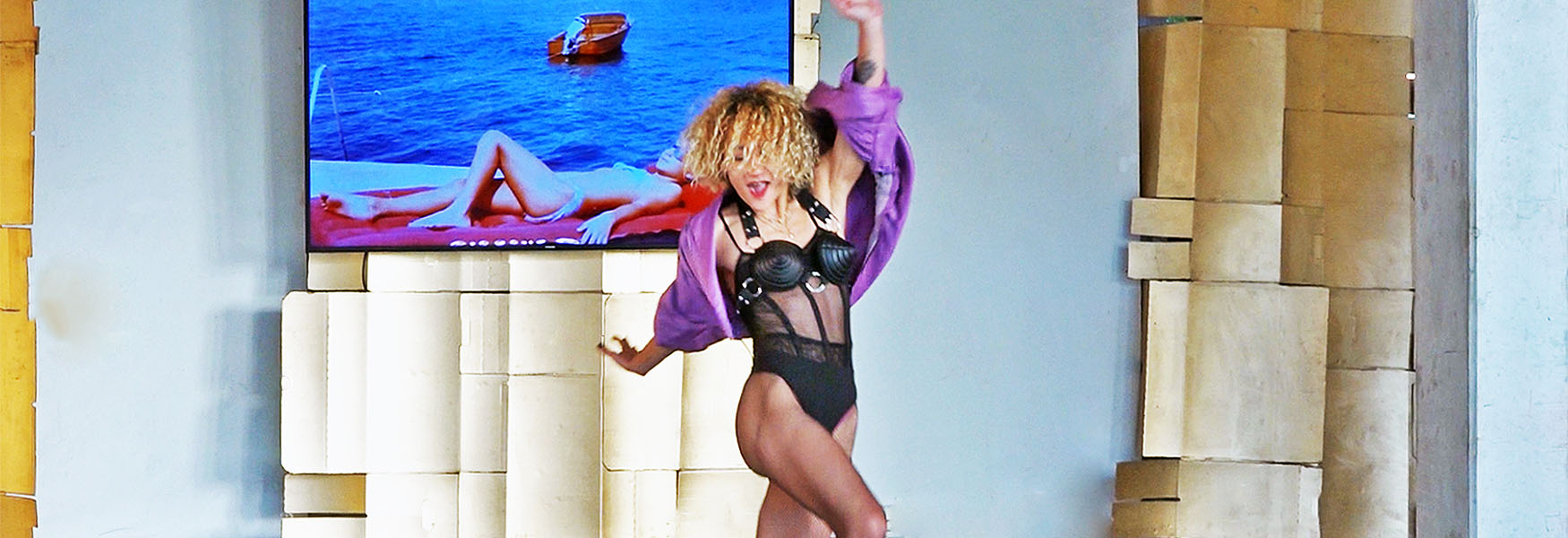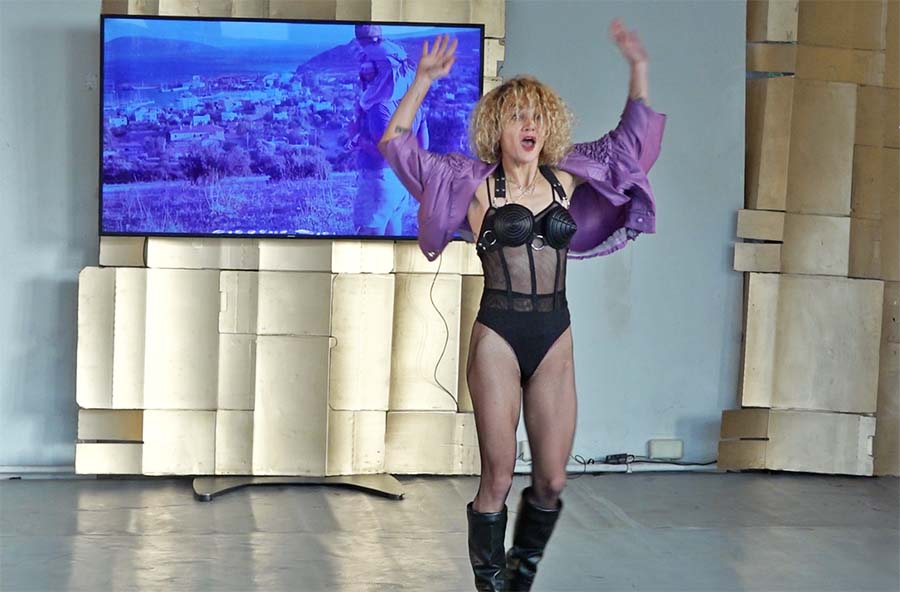Die Choreographie „THE POSE“ von Constanza Macras
Von Holger Jacobs
22.08.2021
Wertung: 🙂 🙂 🙂 (drei von fünf)
Die Photographie als Mittel zur Selbstdarstellung – früher und heute
„The Pose“ der 1970 in Argentinien geborenen Choreographin CONSTANZA MACRAS handelt vom Medium der Photographie und wie sie sich im Zeitalter des Smartphones und der sozialen Medien verändert hat.
Diese choreographische Arbeit, uraufgeführt 2017 in der Akademie der Künste, wird jetzt eine Woche lang jeden Tag in der „Weissen Halle“ der Siemensstadt bin Berlin gezeigt.
Die Reproduktion unserer Umwelt mit den Menschen, die wir lieben, ist ein schon immer dagewesener Wunsch, der vor der Erfindung der Photographie nur durch die Malerei oder der Bildhauerei ermöglicht wurde. Weshalb die Künstler sowohl in der Antike, wie auch später in der Renaissance, Barock und Klassik, immer versucht haben, dem Original am nächsten zu kommen.
Mit wirklich erstaunlichen Erfolgen (hier lohnt sich ein Besuch der Gemäldegalerie oder der Alten Nationalgalerie in Berlin).
Der Mensch als endliches Wesen möchte etwas festhalten, was vergeht und und niemals wiederkommt.
Doch erst mit der Erfindung der Photographie 1839 wurde es möglich, absolut naturgetreu einmal Gesehenes und einmal Geschehenes wiederzugeben.
Die Technik war am Anfang noch sehr dürftig, aber ab der Jahrhundertwende vom 19. zum 20. Jahrhundert war die Technik so verfeinert, dass von der Wirklichkeit absolut identische Reproduktionen möglich wurde.
Der Philosoph und Kunstkritiker WALTER BENJAMIN schrieb zu diesem Thema 1935 in seinem Pariser Exil den Aufsatz:
„Das Kunstwerk im Zeitalter seiner technischen Reproduzierbarkeit“,
Darin weist er auf die Bedeutung des Einmaligen eines traditionellen Kunstwerks hin. „Was im Zeitalter der technischen Reproduzierbarkeit des Kunstwerks verkümmert, das ist seine Aura“, schreibt Walter Benjamin.
Das einmalige Kunstwerk, wie z.B. ein gemaltes Bild, trägt ein kulturelles Erbe in sich, während die modernen technischen Möglichkeiten der Reproduktion zu einer Massenhaftigkeit führt, die ihre Echtheit und Authentizität verliert.
Was hätte Walter Benjamin wohl zur heutigen millionenhaften Verbreitung von selbstgeschossenen Selfies auf Instagram, Facebook und Tik Tok gesagt?
Constanza Macras geht in ihrer Choreographie „The Pose“ auf dieses Thema ein und zeigt, ganz im Stil des Tanztheaters einer PINA BAUSCH, sowohl einzelne Personen wie auch ganze Gruppen, die sich dem Selbstdarstellungswahn hingeben, mit teilweise absurden Ergebnissen.
Ob sich eine Frau, nach der Musik von Madonna tanzend, halbnackt ihrem Publikum zeigt und dabei hofft, möglichst viele „Likes“ zu bekommen, oder ob andere Personen besonders verrückte Posen oder sogar gefährliche „Stunts“ vollführen, nur um Anerkennung zu bekommen, all das ist die Welt, in der wir heute leben.
Unser Video zu „THE POSE“ findet Ihr hier.
Doch Constanza Macras lässt diese Tatsache nicht alleine stehen, sondern vergleicht auch die frühere analoge Photographie mit der heutigen digitalen.
Während noch bis zum Ende des 20. Jahrhunderts der analoge Film das einzige Medium war, photographisch eine Szene festzuhalten, haben wir heute den lichtempfindlichen Chip, der jetzt in allen Kameras eingebaut wird.
Einziges Überbleibsel der alten Zeit:
Das Format des früheren Kleinbildfilms von 24 x 36 cm wurde übernommen, um auch heute die Chips in dieser Größe herzustellen und damit ausgestatte Fotoapparate als „Vollformatkameras“ mit hoher Auflösung zu bezeichnen.
Der wesentliche Unterschied von analog zu digital:
Mit dem Chip können, gespeichert auf SD-Karten mit bis zu 256 Gigabyte, Hunderte, ja Tausende Fotos auf einmal gemacht und gespeichert werden. Auf dem normalen Kleinbildfilm waren es früher gerade mal 36 Bilder, bis der Film gewechselt werden musste.
Das führt jetzt dazu, dass wahllos Fotos von allem Möglichen gemacht wird, sowohl Wichtigem wie auch (zumeist) Unwichtigem.
Und immer mehr Bewegtbild, also Film, bei dem mindestens 24 Bilder pro Sekunde geschossen werden müssen, um die Bewegung für das Auge flüssig erscheinen zu lassen. Mit den riesigen Speicherkapazitäten der SD-Karten ist auch das kein Problem mehr.
Constanza Macras zeigt auf, wie die (analoge) Fotografie in früherer Zeit hauptsächlich zur Dokumentation von wichtigen Ereignissen eingesetzt wurde, wie Hochzeiten, Familienfeiern und der Werdegang der eigenen Kinder – später dann aufwendig als Abzüge in Fotoalben geklebt.
Heute werden Fotos gemacht, nicht um sie in Alben zu kleben, sondern um auf sozialen Medien berühmt zu werden.
Für die Generation Y und Z, also der Millennium-Generation (geboren um die Jahrtausendwende zwischen 1990 – 2010) gibt es keine physischen Erzeugnisse mehr, die irgendwo reingeklebt oder gelagert werden. Alle Fotos sind auf dem Smartphone oder dem Rechner zu Hause gespeichert und bei Bedarf abruf- und vorzeigbar – oder eben als Zeugnisse des eigenen Lebens gepostet auf sozialen Medien.
Ist das nun gut oder schlecht?
Constanza Macras, ausgezeichnet mit dem diesjährigen TABORI-Preis, gibt hier keine Wertung ab, sie stellt nur fest.
„The Pose“ von Constanza Macras
DorkyPark-Tanzensemble
Musik von Robert Lippok
Mit: Candaş Bas, Alexandra Bódi, Emil Bordás, Chia-Ying Chiang, Rob Fordeyn, Luc Guiol, Sonya Levin, Thulani Lord Mgidi, Ana Mondini, Daisy Phillips, Miki Shoji
Spielort: Die Weiße Halle der ehemaligen Siemensstadt
Gartenfelderstr. 14 – 28
13599 Berlin
Vorstellungen: 22., 24., 25., 26., 27., 28., und 29. August 2021
Jeweils um 18.30 Uhr, Dauer: 3,5 Stunden mit einer Pause
Tickets hier
Bildergalerie mit 10 Fotos von „The Pose“:
English text
The choreography “THE POSE” by Constanza Macras
By Holger Jacobs
Photography as a means of communication – then and now
„The Pose“ by choreographer CONSTANZA MACRAS (born in Argentina in 1970), is about the medium of photography and how it has changed in the age of the smartphone and social media.
„The Pose“, premiered in 2017 at the Akademie der Künste, will now be shown every day for a week in the „White Hall“ of Siemensstadt in Berlin.
The reproduction of our environment with the people we love has always been a wish, which before the invention of photography was only possible through painting or sculpture. Which is why artists, both in antiquity and later in the Renaissance, Baroque and Classical periods, always tried to come closest to the original. With really astonishing successes (a visit to the Gemäldegalerie or the Alte Nationalgalerie in Berlin is worthwhile).
Humans are a finite beings who wants to remember something that passes and and never comes back.
But it was only with the invention of photography in 1839 that it became possible to reproduce what had happened once in a true-to-life manner. The technology was very poor at the beginning, but from the turn of the 19th to the 20th century the technology was so refined that absolutely identical reproductions of the reality were possible.
The philosopher and art critic Walter Benjamin wrote an essay on this subject in 1935 in his exile in Paris:
“The work of art in the age of its technical reproducibility”,
in which he points out the importance of the unique character of a traditional work of art.
“What disapears in the age of technical reproducibility of the work of art is its Aura,” writes Walter Benjamin.
The unique work of art, such as a painted picture, bears a cultural heritage, while the modern technical possibilities of reproduction lead to a mass quality that loses its authenticity.
What would Walter Benjamin have said about today’s millions of self-shot portraits on Instagram, Facebook and Tik Tok?
Constanza Macras deals with this topic in her choreography „The Pose“ and shows, in the style of Pina Bausch’s dance theater, how individuals and entire groups try to express themselves in „selfies“, with sometimes absurd results.
Whether a woman, dancing to the music of MADONNA, shows herself half-naked to her audience and hopes to get as many „likes“ as possible, or whether other people perform particularly crazy poses or even dangerous stunts just to get recognition, all this is the world we live in today.
My video of „THE POSE“ you will find here.
Constanza Macras does not leave this fact alone, but also compares the earlier analog photography with today’s digital.
While until the end of the 20th century analog film was the only medium for capturing a scene photographically, today we have the light-sensitive chip that is now built into all cameras.
The only remnant of the old days:
The format of the earlier 35mm film of 24 x 36 cm was adopted in order to still produce the chips in this size today and to designate cameras equipped with them as “full-format cameras” with high resolution.
The main difference between analog and digital:
With the chip, stored on SD cards with up to 256 gigabytes, hundreds, even thousands of photos can be taken and saved. The Film had to be changed after only 36 pictures…
This now leads to endless photos being taken of everything, both important and (mostly) unimportant.
And more and more moving images, means the film, in which at least 24 frames per second have to be shot in order to make the movement appear fluid to the eye. With the huge storage capacities of the SD cards, this is no longer a problem.
Constanza Macras shows how (analog) photography was mainly used in the past to document important events, such as weddings, family celebrations and the careers of one’s own children – later then elaborately glued as prints in photo albums.
Today, people take pictures, not to glue in albums, but to get famous in social media!
For the Generation Y and Z, the Millennium Generation (born around the turn of the millennium between 1990 – 2010) there are no longer any physical products that are stuck somewhere. No printing – no albums anymore.
All photos are stored on the smartphone or computer at home and can be called up and presented as required – or posted on social media as testimonies of one’s own life.
Is this good or bad?
Constanza Macras, who was awarded this year’s TABORI Prize, does not give a rating here, she just makes a statement.
“The Pose” by Constanza Macras
DorkyPark-Dance Company
Musik by Robert Lippok
With: Candaş Bas, Alexandra Bódi, Emil Bordás, Chia-Ying Chiang, Rob Fordeyn, Luc Guiol, Sonya Levin, Thulani Lord Mgidi, Ana Mondini, Da Phillips, Miki Shoji
Venue: The White Hall of the former Siemensstadt
Gartenfelderstr. 14 – 28
13599 Berlin
Performances: 22nd, 24th, 25th, 26th, 27th, 28th and 29th August 2021, each at 6.30 p.m., duration: 3.5 hours with a break
Tickets here
Here our picture series of 10 photos of „The Pose“:
Author: Holger Jacobs
Founder & Editorial Director of kultur24.berlin ug.
Founder & Editorial Director of kultur24 TV on Youtube.
Former correspondent for fashion in Paris.
Photographer, writer and filmmaker.















